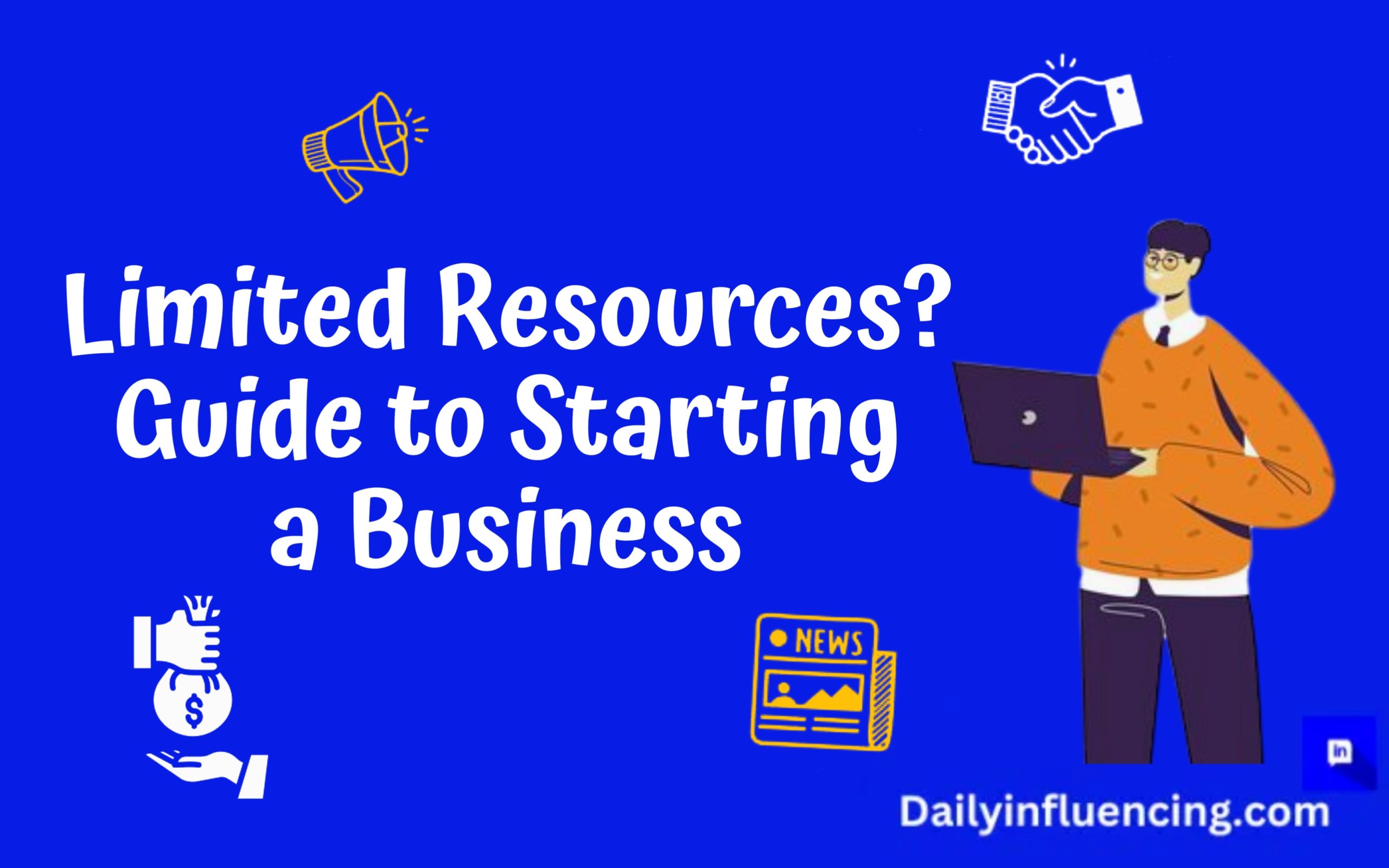
Start your dream business without breaking the bank. Learn how to leverage limited resources & achieve success.
Starting a business can be a thrilling we experience, but it can also be daunting. Meanwhile, many entrepreneurs struggle to turn their business ideas into reality due to financial constraints, or limited skills. Consequently, they often find themselves stuck in a cycle of uncertainty and doubt.
However, with the right mindset, strategy, and support, entrepreneurs can overcome these challenges and build a successful business. In fact, many successful entrepreneurs have started their businesses with limited resources and have gone on to achieve great things.
In this guide, we will explore the unique challenges of starting a business with limited resources and provide practical tips and strategies for overcoming them. Furthermore, we will examine the key skills and mindset required to succeed as an entrepreneur. Additionally, we will look at real-life examples of entrepreneurs who have successfully started and grown their businesses with limited resources.
Whether you’re a solo entrepreneur, a small business owner, or an aspiring entrepreneur. This guide will provide you with the insights and tools you need to turn your business idea into a reality. Ultimately, our goal is to empower you with the knowledge and confidence you need to succeed as an entrepreneur, regardless of your resources.
Starting a Business with Limited Resources
When starting a business, entrepreneurs often face numerous challenges. Meanwhile, those with limited resources encounter a unique set of obstacles. Consequently, they must develop innovative strategies to overcome these hurdles.
To begin with, entrepreneurs with limited resources must cultivate creativity and resourcefulness. Additionally, they must be adaptable and willing to pivot when circumstances change. Furthermore, they must develop a solid understanding of their business and its needs.
In this context, entrepreneurs with limited resources must prioritize their spending. Firstly, they must focus on essential activities that drive revenue and growth. Secondly, they must seek out free or low-cost resources, such as online tutorials and business mentors. Moreover, they must leverage their network and build relationships with potential partners and investors.
Ultimately, starting a business with limited resources demands a unique combination of creativity, resilience, and determination. By developing the right mindset and strategies, entrepreneurs can overcome the challenges of limited resources and achieve success.
Assessing and Maximizing Your Resources
When starting a business with limited resources, it’s essential to conduct a thorough assessment of your available resources. This involves taking stock of your financial resources, skills, strengths, network, and support system. By doing so, you’ll be able to identify areas where you can optimize your resources and make the most of what you have.
Evaluating Your Financial Resources
To begin with, you’ll need to assess your financial situation and determine how much capital you have available to invest in your business. This involves creating a personal budget and calculating your startup costs. You’ll also need to explore funding options, such as loans, grants, and crowdfunding, to determine which ones are best suited for your business.
Identifying Your Skills and Strengths
Next, you’ll need to take stock of your skills and strengths to determine how they can be leveraged to drive your business forward. This involves conducting a skills assessment and identifying areas where you excel. You’ll also need to consider how your skills and strengths can be used to create value for your customers.
Determining Your Network and Support System
Finally, you’ll need to assess your network and support system to determine who can provide guidance, mentorship, and support as you navigate the challenges of starting a business with limited resources. This involves identifying key stakeholders, such as mentors, advisors, and peers, who can provide valuable insights and connections.
Choosing a Business Model that Thrives with Limited Resources
Here are key considerations for choosing a business model:
- Assess Your Goals: Determine what you want to achieve with your business and choose a model that aligns with your objectives.
- Evaluate Business Models: Explore solo entrepreneurship, partnerships, LLCs, online business models, franchises, and licensing agreements to determine which one works best for you.
- Consider Costs: Calculate startup costs, operational expenses, and marketing budgets for each business model.
- Analyze Revenue Streams: Evaluate potential revenue streams and growth opportunities for each business model.
- Choose a Flexible Model: Select a business model that allows for flexibility and adaptability in response to changing market conditions.
- Research Successful Businesses: Study successful businesses that started with limited resources and learn from their experiences.
Developing a Business Plan for Success
Now that we’ve explored the importance of choosing a business model that thrives with limited resources, it’s essential to develop a solid business plan. Consequently, this plan will serve as a roadmap for your business, guiding your decisions and actions.
To start with, entrepreneurs must recognize the importance of a business plan for startups with limited resources. Firstly, a business plan helps clarify your vision, mission, and objectives. Additionally, it enables you to assess market opportunities, develop a marketing strategy, and create a financial plan.
Importance of a Business Plan for success with Limited Resources
The key components of a business plan include:
- Market Analysis: Research your target market, competition, and potential revenue streams.
- Financial Projections: Establish a budget, forecast revenue, and manage cash flow.
- Marketing Strategy: Outline marketing tactics, budget, and metrics for success.
- Operational Plan: Define business operations, management structure, and human resources.
Key Components of a Business Plan
When creating a business plan with limited resources, entrepreneurs should:
- Keep it Simple: Focus on essential elements and avoid unnecessary complexity.
- Use Free Resources: Leverage online templates, business planning tools, and mentorship programs.
- Review and Revise: Regularly review and update the business plan to reflect changing market conditions and business needs.
Securing Funding and Managing Finances
Moving forward, entrepreneurs must secure funding and manage finances effectively to sustain their business. Firstly, they can explore funding options such as bootstrapping, crowdfunding, and small business loans.
To secure funding, entrepreneurs should:
- Develop a Strong Pitch: Clearly articulate their business idea, mission, and financial projections.
- Build a Solid Financial Plan: Establish a budget, forecast revenue, and manage cash flow.
- Leverage Alternative Funding Options: Consider grants, incubators, and accelerators.
Building a Team and Network with Limited Resources
As entrepreneurs progress, they must build a team and network to drive business growth. Initially, they can leverage their existing network, including friends, family, and colleagues.
To build a team, entrepreneurs should:
- Hire Multitalented Individuals: Recruit team members who can handle multiple responsibilities.
- Leverage Freelancers and Interns: Utilize freelancers and interns to fill skills gaps and reduce labor costs.
- Foster a Strong Company Culture: Encourage collaboration, innovation, and open communication.
Marketing and Growing Your Business with Limited Resources
Moving into marketing strategies for startups with limited resources. Initially, entrepreneurs must recognize that marketing is crucial for business growth.
Marketing Plan on a Limited Budget
To create a marketing plan on a limited budget, entrepreneurs should:
- Set Clear Objectives: Define specific, measurable, achievable, relevant, and time-bound (SMART) marketing goals.
- Identify Target Audiences: Determine the demographics, needs, and preferences of your ideal customers.
- Develop a Unique Value Proposition: Clearly articulate your business’s unique benefits and competitive advantages.
Low-cost Marketing Tactics
Next, entrepreneurs can leverage low-cost marketing tactics, such as:
- Social Media Marketing: Utilize platforms like Facebook, Twitter, and Instagram to reach target audiences.
- Content Marketing: Create and share valuable, relevant, and consistent content to attract and retain customers.
- Email Marketing: Build and leverage an email list to promote products or services.
CONCLUSION
In conclusion, starting a business with limited resources requires careful planning, creativity, and perseverance. Throughout this guide, we’ve explored the importance of assessing and maximizing resources, choosing a business model, developing a business plan, securing funding, building a team and network, and marketing and growing your business.
To recap, key takeaways include:
- Be Resourceful: Leverage your skills, network, and available resources to overcome limitations.
- Stay Flexible: Adapt to changing market conditions and customer needs.
- Focus on Value: Deliver unique benefits and value to your customers.
Finally, remember that starting a business with limited resources is not only challenging but also rewarding. By staying committed to your vision and being willing to learn and adapt, you can overcome obstacles and achieve success.
As you embark on your entrepreneurial journey, keep in mind that:
– Every Small Step Counts: Celebrate your progress, no matter how small.
– Learning is Key: Continuously educate yourself on new skills, strategies, and industry trends.
– Resilience is Essential: Develop a growth mindset and bounce back from setbacks.
Stay motivated, stay focused, and most importantly, stay committed to your entrepreneurial dreams!




